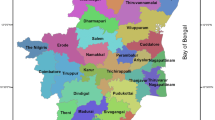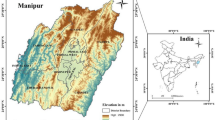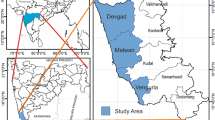Abstract
This study highlighted the social vulnerability to climate change of 29 eastern coastal districts across 4 eastern coastal states of India by using the ‘Integrated vulnerability assessment approach’ and IPCC’s definition of vulnerability. The assessment was based on secondary data, like socio-economic and bio-physical indicators, collected from several authenticated sources; and weightage of these indicators were assigned by using Principal Component Analysis. Vulnerability was calculated as the net affect of exposure and sensitivity on the adaptive capacity. Pudukottai district of Tamil Nadu was found to be the most vulnerable district, while East Godavari district of Andhra Pradesh was the least vulnerable. The net effect was found to be negative in 10 districts: South 24-Parganas of West Bengal; Bhadrak of Odisha; Prakasam of Andhra Pradesh; Thiruvallur, Villipuram, Thanjavur, Thoothukkudi, Pudukottai, Ramanathapuram and Cuddalore of Tamil Nadu. This net negative effect may be considered as an indicator of alarming situation.


Similar content being viewed by others
Explore related subjects
Discover the latest articles and news from researchers in related subjects, suggested using machine learning.Notes
Statistical Hand Book of Tamil Nadu-2012 (http://www.tn.gov.in/deptst/); District Statistical Hand Book of Srikakulam, Visakhapatnam, West Godavari, East Godavari, Krishna, Guntur, Prakasam, S.P.S. Nellore, Vizianagaram, Directorate of Economics and Statistics, Government of Andhra Pradesh, Hyderabad, India; District Statistical Hand Book of Blasore, Bhadrak, Jgatsinghpur, Puri, Kendrapara, Ganjam, Directorate of Economics and Statistics, Government of Odisha, Bhubneswar, India; District Statistical Hand Book of North 24-Parganas, South 24-Parganas, Purba Medinipur, Directorate of Economics and Statistics, Government of West Bengal, Kolkata, India (Hard copy of the report were collected)
References
Adger WN (1999) Social vulnerability to climate change and extremes in Coastal Vietnam. World Dev 27(2):249–269
Adger WN, Kelly PM (1999) Social vulnerability to climate change and the architecture of entitlements. (IPCC Special Issue on ‘Adaptation to Climate Change and Variability’). Mitig Adapt Strateg Glob Chang 4(3–4):253–266 (R)
Canadian International Development Agency (CIDA) (2003) Methodology used in the CIDA study: An example of India. AIACC Asia-Pacific Region Open Meeting. http://www.aiaccproject.org/meetings/Bangkok_03/Workshop%20presetations/C1_S_Bhadwal.ppt. Accessed 20 Aug 2011
Deressa TT, Hassan RM, Ringler C (2008) Measuring Ethiopian farmers’ vulnerability to climate change across regional states. IFPRI Discussion Paper 00806. International Food Policy Research Institute, Washington
Deressa TT, Hassan RM, Ringler C (2009) Assessing household vulnerability to climate change. The case of farmers in the Nile basin of Ethiopia. IFPRI discussion paper 00935. International Food Policy Research Institute, Washington
Feroze SM, Chauhan AK (2010) Performance of dairy self help groups in India: principal component analysis approach. Indian J Agric Econ 65(2):308–320
Gbetibouo GA, Ringler C (2009) Mapping south African farming sector vulnerability to climate change and variability. A subnational assessment. IFPRI discussion paper 00885. International Food Policy Research Institute (IFPRI), Washington
Hahn MB, Riederer AM, Foster SO (2009) The livelihood vulnerability index: a pragmatic approach to assessing risks from climate variability and change—a case study in Mozambique. Glob Environ Chang Vol 19(1):74–88
Intergovernmental Panel on Climate Change (IPCC) (2001) In: McCarthy J, Canziani O, Leary N, Dokken D, White K (eds) Climate change 2001: impacts, adaptation, and vulnerability. Cambridge University Press, Cambridge
Kelly PM, Adger WN (2000) Theory and practice in assessing vulnerability to climate change and facilitation adaptation. Clim Chang 47(4):925–1352
Kumar KS, Tholkappian S (2005) Relative vulnerability of Indian coastal districts to sea-level rise and climate extremes. Int Rev Environ Strateg 6(1):3–22
Kumar TS, Mahendra RS, Nayak S, Radhakrishnan K, Sahu KC (2010) Coastal vulnerability assessment for Orissa state, east coast on India. J Coast Res 26(3):523–534
Leary N, Adejuwon J, Bailey W, Barros V, Batima P, Caffera RM, Cinvanno S, Conde C, Comarmond AD, Sberbinin AD, Downing T, Eakin H, Nyong A, Opondo M, Osman-Elassha B, Payet R, Pulbin F, Pulbin J, Ratnisri J, Sanjak E, Maltitz MW, Yin Y, Ziervogel G (2008) For whom the bell tolls: Vulnerability in a changing climate. In: Leary N, Conde C, Kulkarni J, Nyong A, Pulbin J (eds) Climate change and vulnerability. Earthscan, London, pp 3–30
McCarthy JJ, Canziani OF, Leary NA, Dokken DJ, White KS (2001) Climate change 2001: impacts, adaptation and vulnerability. Cambridge University Press, Cambridge
Mimura N (2013) Sea-level rise caused by climate change and its implications for society, Proceedings of the Japan Academy. Ser B Phys Biol Sci 89(7):281–301
Mohanty AK, Kumar GAK, Singh BB, Meera SN (2009) Developing multidimensional scale for effective measurement of rural leadership. Indian Res J Ext Educ 9(2):57–63
Moreno A, Becken S (2009) A climate change vulnerability assessment methodology for coastal tourism. J Sustain Tour 17(4):473–488
Nelson R, Kokic P, Crimp S, Meinke H, Howden SM (2010) The vulnerability of Australian rural communities to climate variability and change: part I - conceptualizing and measuring vulnerability. Environ Sci Policy 13:8–17
Nyong A, Dabi D, Adepetu A, Berthe A, Ibemegbulem V (2008) Vulnerability in the sahelian zone of northern Nigeria: a household-level assessment. In: Leary N, Conde C, Kulkarni J, Nyong A, Pulbin J (eds) Climate change and vulnerability. Earthscan, London, pp 218–238
O’Brien K, Leichenko R, Kelkar U, Venema H, Aandahl G, Tompkins H, Javed A, Bhadwal S, Barg S, Nygaard L, West J (2004) Mapping vulnerability to multiple stressors: climate change and globalization in India. Glob Environ Chang 14:303–313
Patnaik U, Narayanan K (2005) Vulnerability and Climate Change: An analysis of the eastern coastal districts of India. Published in International workshop on “Human security and climate change” at Holmen Fjord Hotel, Asker, near Oslo, 21–23 June 2005 organised by Centre for the Study of Civil War, International Peace Research Institute, Oslo (PRIO), Centre for International Environmental and Climate Research at the University of Oslo (CICERO) and the Global Environmental Change and Human Security Program (GECHS)
Patwardhan A, Narayanan K, Parthasarathy D, Sharma U (2003) Assessment of Vulnerability and Adaptive Capacity in Coastal Zones. In: Shukla (ed) Climate change and India vulnerability assessment and adaptation. Universities Press, Hyderabad
Piya L, Maharjan KL, Joshi NP (2012) Vulnerability of rural households to climate change and extremes: Analysis of Chepang households in the mid-hills of Nepal. Selected paper prepared for presentation at the International Association of Agricultural Economics (IAAE) Triennial Conference, Foz do Iguacu, Brazil
Rama Rao CA, Raju BMK, Subba Rao AVM, Rao KV, Rao VUM, Kausalya R, Venkateswarlu B, Sikka AK (2013) Atlas on vulnerability of Indian agriculture to climate change. Central Research Institute for Dryland Agriculture, Hyderabad, p 116
Ravindranath NH, Rao S, Sharma N, Nair M, Gopalakrishnan R, Rao AS, Malaviya S, Tiwari R, Sagadevan A, Munsi M, Krishna N, Bala G (2011) Climate change vulnerability profiles for North east India. Curr Sci 101(3):384–394
Rishi P, Mudaliar R (2014) Climate stress, behavioral adaptation and subjective well being in coastal cities of India. Am J Appl Psychol 2(1):13–21
Seidl R, Rammer W, Lexer MJ (2011) Adaptation options to reduce climate change vulnerability of sustainable forest management in the Austrian Alps. Can J For Res 41:694–706
Strauss B, Kulp S (2014) New analysis shows global exposure to sea level rise, Climate Central, Retrieved from http://www.climatecentral.org/news/new-analysis-global-exposure-to-sea-level-rise-flooding-18066 on Dec 16 2014
Tambe S, Arrawatia ML, Bhutia NT, Swaroop B (2011) Rapid, cost-effective and high resolution assessment of climate-realted vulnerability of rural Communities of Sikkim Himalaya, India. Curr Sci 101(2):165–173
Udayakumar P (2014) Effects of sea level change on vulnerable east coast of India. Res J Mar Sci 2(1):1–5
Vincent K (2004) Creating an index of social vulnerability to climate change for Africa. Technical Report 56. Tyndall Center for Climate Change Research, University of East Anglia, Norwich
Wong PP, Losada IJ, Gattuso JP, Hinkel J, Khattabi A, McInnes KL, Saito Y, Sallenger A (2014) Coastal systems and low-lying areas. In: Field CB, Barros VR, Dokken DJ, Mach KJ, Mastrandrea MD, Bilir TE, Chatterjee M, Ebi KL, Estrada YO, Genova RC, Girma B, Kissel BE, Levy AN, MacCracken S, Mastrandrea PR, White LL (eds) Climate change 2014: impacts, adaptation, and vulnerability. Part a: global and sectoral aspects. Contribution of working group II to the fifth assessment report of the intergovernmental panel on climate change. Cambridge University Press, Cambridge, pp 361–409
Acknowledgments
Authors acknowledge the contributions of National Initiative on Climate Resilient Agriculture (NICRA) at NDRI, Karnal, India for timely help and cooperation during the research work; and ADG (MR), National Climate Centre, IMD, Pune for providing climatic data. We also extend our gratitude to the Director, ICAR-National Dairy Research Institute, Karnal, Haryana, India for guidance, support and encouragement.
Author information
Authors and Affiliations
Corresponding author
Rights and permissions
About this article
Cite this article
Maiti, S., Jha, S.K., Garai, S. et al. Assessment of social vulnerability to climate change in the eastern coast of India. Climatic Change 131, 287–306 (2015). https://doi.org/10.1007/s10584-015-1379-1
Received:
Accepted:
Published:
Issue Date:
DOI: https://doi.org/10.1007/s10584-015-1379-1




